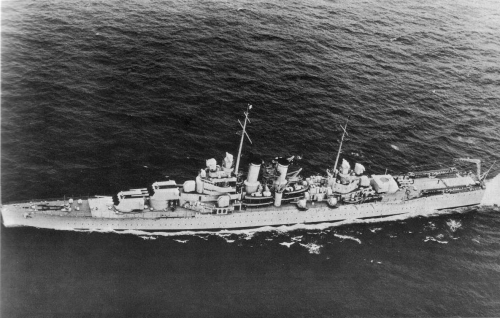

Wichita 1945
| No | Name | Yard No | Builder | Laid down | Launched | Comm | Fate |
| CA45 | Wichita | Philadelphia N Yd // New York SB, Camden | 28.10.1935 | 16.11.1937 | 16.2.1939 | stricken 3.1959 |
|
Displacement standard, t |
10589 |
|
Displacement full, t |
13015 |
|
Length, m |
182.9 wl 185.4 oa |
|
Breadth, m |
18.8 |
|
Draught, m |
7.24 full load |
|
No of shafts |
4 |
|
Machinery |
4 sets Parsons geared steam turbines, 8 Babcock & Wilcox boilers |
|
Power, h. p. |
100000 |
|
Max speed, kts |
33 |
|
Fuel, t |
oil 1323 - 1984 |
| Endurance, nm(kts) | 10000 (15) |
|
Armour, mm |
belt: 152 - 102 on 16mm STS plating, bulkheads: 152, deck: 57, barbettes: 178, turrets: 203 - 38, CT: 152 sides, 57 roof |
|
Armament |
3 x 3 - 203/55 Mk 12.15, 8 x 1 - 127/38 Mk 12, 8 x 1 - 12.7/90, 2 catapults, 4 seaplanes (SOC) |
|
Complement |
929 |
Project history: According to decisions of 1930 London Naval conference, the USA could lay down one heavy cruiser in 1934 (ÑÀ44 Vincennes of New Orleans class) and one more in 1935. In March, 1934 it was decided to build latter ship under the new design, on basis of Brooklyn with replacement of 152mm guns by 203mm. A thickness of main belt was raised to 152mm, barbettes to 178mm. Main lack of previous 203mm turrets was too wide shells spread because of insufficient distance between barrels. This distance was made bigger in new turrets without increasing of barbette diameter (barbettes were made conical, not cylindrical). Structure and arrangement of machinery was the same, as well as on last two ships of Brooklyn class: boiler room with six of eight boilers took places before fore engine room, and two remained boilers were installed in boiler room arranged between two engine rooms. Armour protection provided to a cruiser an immune zone under fire of 203mm guns in a band from 50 to 110 cables. In addition to 203mm guns cruiser carried new 127/38mm DP guns, placed not aside, but on diamond-shaped scheme, that notably improved fire sectors. As the design provided much lighter 127/25mm AA guns, stability after installation of 127/38mm guns began to call serious fears. Exit has been found in 200t of lead ballast.
Ship protection: Main belt abreast machinery extended to 1.5m below and 2.86m over waterline. It was 152mm thick (76mm at lower edge) on 16mm STS plating. There were narrow belts abreast magazines. Thickness of these belts was 102mm decreasing to 76mm at lower edge. Magazines were protected by 152mm bulkheads fore and aft, machinery and magazines were separated by 152mm bulkheads. Armoured deck over main belt was 57mm. Barbettes were 178mm thick. Turrets had 203mm faces, 95mm sides, 38mm rears and 70mm crowns.
Modernizations: 7.1941: + 2 x 4 - 28/75 Mk 1, CXAS Mk 1 radar
4/1942: - 8 x 1 - 12.7/90, CXAS Mk 1 radar; + 12 x 1 - 20/70 Mk 4, SC, 2x Mk 4, Mk 8 radars
11/1943: - 2 x 4 - 28/75, SC, Mk 8 radars; + 4 x 4 - 40/56 MK 1.2, 2 x 2 - 40/56 Mk 1.2, 6 x 1 - 20/70 Mk 4, SG, SK-1, Mk 13 radars
1945: - 2 x Mk 4 radars; + 2 x 2 - 40/56 MK 1.2, 2 x Mk 25 radars, full displacement was 14611t
1/1946: 3 x 3 - 203/55 Mk 12, 4 x 1 - 127/38 Mk 21/24, 4 x 1 - 127/38 Mk 30, 4 x 4 - 40/60 Mk 2, 4 x 2 - 40/60 Mk 1, 18 x 1 - 20/70 Mk 10, 2 catapults, 4 seaplanes, SG, SK-1, 2x Mk 25, Mk 13 radars
Naval service: No significant events.

Wichita 1940
© Ivan Gogin, 2014